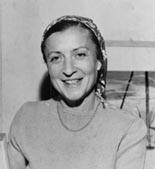
Anna-Eva Bergman’s refined and spiritual abstraction remains a powerful achievement of 20th-century European painting. Growing up in Sweden and Norway, she studied at the Academy of Fine Arts in Oslo and later at the University of Vienna, before moving to Paris in 1929, where she met Hans Hartung, a German-born French artist with whom she would form both a personal and professional partnership. Their union provided a fertile ground for creative exchange, and while Hartung became internationally celebrated for his bold, gestural abstraction, Bergman developed her own distinct artistic voice, characterized by a quiet, introspective minimalism. Though long overshadowed by the work of her husband Hans Hartung, Bergman’s oeuvre has in recent years been re-evaluated and embraced for its balance of austerity, lyricism, and inner luminosity.
During the 1930’s the couple lived and worked in Menorca, but with the outbreak of war and concerns about Hartung’s German nationality the couple separated, with Bergman returning to Norway working with the Resistance. They were reunited in Paris in 1952, and with the encouragement of Pierre Soulages, she began exhibiting in the avant-garde Salon de Mai shows, which led to solo shows at Galerie Ariel, and Galerie La Hune in 1955, as well as inclusion in the influential “Divergences” shows at Galerie Arnaud. She also participated in the Salon des Réaités Nouvelles exhibitions, and joined Galerie de France in 1958 exhibiting regularly until 1977.
Working primarily with metal leaf—silver, gold, copper—on canvas, paper, or board, Bergman reduced the landscape to its most essential forms. She distanced herself from traditional landscape painting, instead opting to abstract the forces of nature into elemental shapes and textures that allude to the sublime beauty of Nordic coastlines, glaciers, and the vast open skies. Vertical cliffs, arctic light, silent fjords, and glacial masses are abstracted into simple geometric shapes. Her compositions resist narrative or overt symbolism; instead, they evoke the atmosphere and quiet monumentality of the natural world. These are not representations of place, but meditations on the balance between light and dark, space and volume. Bergman’s work is restrained, inviting contemplation, and offering a sensory and emotional experience.
While undoubtedly under recognised in her lifetime, Bergman was awarded a retrospective at the Musée d’Art Moderne de Paris in 1977; but in recent years appreciation of her work has increased significantly with inclusion in “Femmes Années 50s” at the Musée Soulages in 2019; “Anna-Eva Bermand: A Journey Within” at the Musée d’Art Moderne de Paris, 2023; and “Anna-Eva Bergman & Hans Hartung: And We’ll Never Be Parted”, Kunsthalle, Prague, 2025.
Today, Anna-Eva Bergman’s legacy is firmly established, with works held in major museum collections across Europe and beyond. Her paintings can be found in the Musée d’Art Moderne de Paris, Centre Pompidou, and the Musée National d’Art Moderne in France, as well as the National Museum in Oslo. Internationally, her works are represented in the Museo Nacional Centro de Arte Reina Sofía in Madrid, the Moderna Museet in Stockholm, and the Fondation Hartung-Bergman in Antibes, which preserves her archives and continues to promote her legacy.